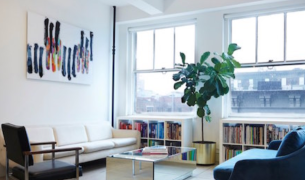This website uses cookies, by continuing to use this website you consent to the use of cookies.
Design x Fashion
The Charles works closely with the intersection between digital and fashion, and so I attended the third annual AIGA Design Week Design x Fashion talk at the Parsons School of Design. The talk, moderated by Piera Gelardi, Executive Creative Director of Refinery 29, featured prominent Creative Directors from different areas of fashion. The talk was segmented into three distinct themes informed by the speaker’s experiences in the field: 1. Authenticity, 2. Storytelling, and 3. Intuition.
Greg Foley is a founding member and Creative Director of Visionaire, V Magazine, VMAN and VFiles. His talk centered around creating authentic content in an industry saturated with trends and repetition. Greg emphasized on not only creating authentic content, but finding authentic inspiration as the key to ground-breaking, memorable design. As a creative, I have experienced how challenging it is to get stuck in a rut while working on a project. Often the rut is fueled by looking at the same sources for inspiration, which limits new creativity. To find authentic inspiration, Greg suggests looking at other cultures for sourcing inspiration and striving to create something you have never seen before.
“I am still a student, finding answers to creative questions. Asking questions lead to creativity,” said Greg who attended RISD, majoring in Fashion. He was inspired by fashion publications, which led him to create one of the most revolutionary publications, Visionaire. This magazine used experimental mixed-media for each publication, such as leather, metal, cloth, etc., and thus reimagined what a publication could be. Greg played with the relationship between the medium and the story, something all digital experience designers like us are challenged to do.
The challenge for digital designers is to create tactile, personalized experiences with a website, a medium that has limited access to physical touch points. Consumers are extremely attracted to the tactile experience a magazine provides, and replicating this humanized experience in digital is becoming the common task. Crafting these visceral, unique experiences that resonate with the user long after viewing the site, is something I strive to do on every site I design. Since there is so much transient content on the web, creating a meaningful and engaging experience for users is important for a successful brand impression and continued brand loyalty.
Kristen Naiman, on the other hand, focused on how to create a universal narrative to directly connect campaigns to consumers. Kristen is the VP of Brand Creative at Kate Spade and has been the voice of the brand through seasonal print and film campaigns. Kristen had created numerous fashion campaigns that treat the product as a character in order to humanize product placement in native brand campaigns. Kristen noted that it is more challenging to sell a lifestyle in a convincing way versus just selling a product. However, selling the lifestyle makes the consumers feel part of the brand story and ensures continual engagement. Creating a space where the users feel part of the community is key for brand loyalty, and making them feel like individuals within a “tribe” is even more important.
The most relevant note Kristen made was how to make creatively compelling singular images that live within a larger narrative. An example for this is website creation, where each interactive diagram, graphic, and illustration needs to hold its own weight, all while complimenting and facilitating the larger story. In talking about new technologies, specifically Virtual Reality (VR), Kristen noted that the technology has not found a story to match the technology, and all VR seems like experiments because the technology hasn’t found its footing yet.
Nicola Formichetti was the least traditional of the three speakers, but provided a refreshing perspective because of his unique experiences working in the field without college experience. Now the Creative Director of Diesel and NicoPanda, Nicola was once known as the creative who styled Lady Gaga for years, specifically in her infamous meat dress. His background was less formal, as he learned all of his skills on the job and through life experiences. Successful designers like Nicola are fascinating to me as my background is more formal. Yet, like my mentor and favorite designer Aaron Draplin, they started off not going to college and learned everything on the job. Nicola broke his talk up into the four pillars he considered crucial for creative success: 1. Point of View, 2. Intuition, 3. Curiosity, and 4. Visualization.
Nicola, like many creatives, never felt like he fit in, so he gravitated towards art because all of the misfits he resonated with were working in that space. Influenced by London subculture, he started off at one of the most popular shops in London, The Pineal Eye, frequented by Raf Simons and Jeremy Scott. The lessons Nicola learned from working in the store and meeting elite designers like these strengthened his intuition while creating, leading to more confidence in his work.
My goal in design school was to find my intuition and to design based off of feeling, which is something that only happens when you have spent years studying and being exposed to curated aesthetics. Nicola has since gone on to work for Dazed, Mugler, Vogue, Free Magazine, and now works for Diesel. From Lady Gaga, he learned his fourth point, Visualization, when you see the concept in your head and then go out an execute that concept in physical form. This is something that becomes more intuitive as a designer’s career progresses, but is constantly challenged by criticism and failures. He specifically referenced the backlash he got for the meat dress Lady Gaga wore, and coping with the extreme criticism and hate he received. Learning how to filter through the criticism, and turning the hate into fuel for producing something better, is Nicola’s biggest defining characteristic. But even he admits he is human and the criticism does get to him, but people just have to prioritize and filter which criticism to let in.
These designers all showcased diverse media to tell a brand story. I wrote my senior thesis on this topic, so it was enlightening to hear Nicola, Kristen, and Greg’s interpretation of branding across different media, leveraging the strengths of that specific medium, and using that medium purposefully to create brand loyalty.



